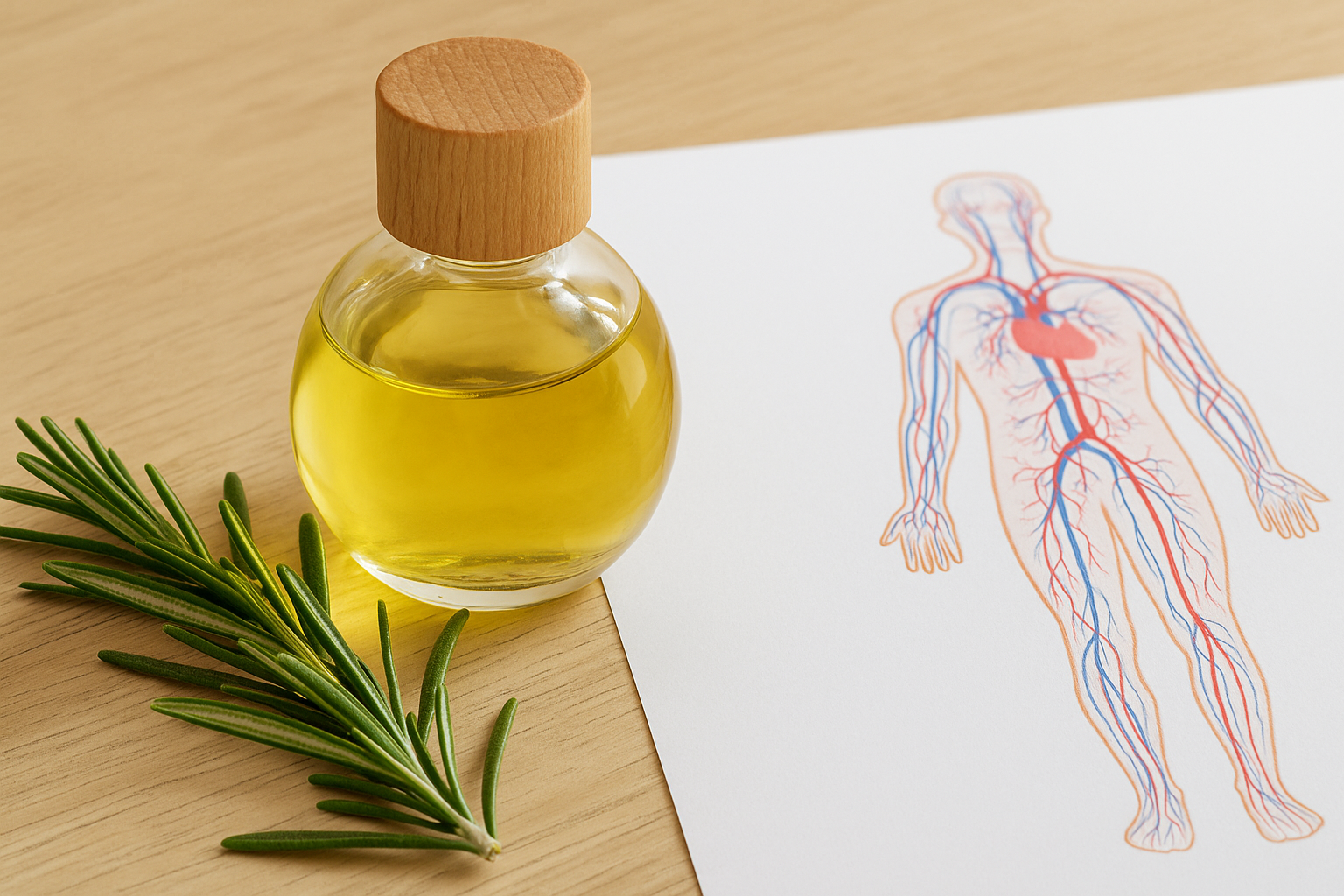Essential oils have been used for centuries in medicine, rituals, and everyday life. They are concentrated essences extracted from plants, carrying complex molecules that affect both the body and the mind.
Today, science offers explanations for what traditional cultures always knew: essential oils interact with the nervous system, immune response, skin, and even emotions.
In Southern Brazil, Gaúcho herbs like marcela, rosemary, boldinho, guaco, carqueja, and white sage are not just cultural symbols.
They contain compounds proven to influence health. Understanding how these oils interact with the body allows us to use them more effectively and safely in modern life.
This article explores the science of essential oils, their pathways in the body, the compounds responsible for their effects, and practical ways to integrate Gaúcho herb oils into daily routines.
What essential oils are made of
Essential oils are not single substances. They are complex mixtures of volatile organic compounds (VOCs). Each plant produces a unique profile of molecules, giving its oil specific fragrance and properties.
- Terpenes: Provide aroma and often antimicrobial effects. Rosemary is rich in pinene and cineole, which improve focus and clear the airways.
- Phenols: Strong antioxidants and stimulants. Found in sage, they support immunity but must be used carefully due to potency.
- Flavonoids: Present in marcela, these compounds reduce stress and calm the nervous system.
- Coumarins: Found in guaco, they dilate airways and aid breathing.
- Sesquiterpenes: Heavier molecules like those in carqueja that last longer and ground blends.
Each oil is essentially a chemical orchestra, not a single note. Their complexity explains why they work in so many ways.
How the body absorbs essential oils
Through inhalation
When inhaled, essential oil molecules travel through the nose to the olfactory bulb. This region connects directly to the limbic system, which governs emotion and memory. That is why a smell can trigger a flood of feelings instantly. Rosemary sharpens focus within seconds because cineole stimulates brain regions linked to alertness.
Through skin absorption
Essential oils penetrate the skin due to their lipophilic nature. Once inside, they interact with capillaries and reach systemic circulation. Diluted in carrier oils, marcela or sage can calm the body through topical application.
Through ingestion (with caution)
Some traditions consume oils diluted in teas or syrups, like guaco. Science confirms coumarins from guaco reach the bloodstream and relax the bronchi. However, ingestion of pure essential oils is risky without guidance. Safer alternatives are tinctures and infused teas.
Interactions with the nervous system
Essential oils influence neurotransmitters.
- Rosemary increases acetylcholine activity, improving memory.
- Marcela boosts serotonin, aiding relaxation and sleep.
- Sage interacts with GABA receptors, calming the nervous system.
Smell bypasses rational filters. That is why a rosemary sprig can improve study performance or a marcela mist can ease insomnia within minutes.
Interactions with the respiratory system
Inhaling oils not only activates the brain but also directly affects the lungs. Molecules like cineole (rosemary) and coumarin (guaco) clear mucus and relax airways. That explains why steam inhalation with herbs relieves colds.
Carqueja contributes by reducing inflammation in the respiratory tract, while sage smoke is antimicrobial, reducing airborne bacteria.
Interactions with the skin
Essential oils penetrate through hair follicles and sebaceous glands. They regulate oil production, fight microbes, and improve circulation. Rosemary oil stimulates the scalp, marcela soothes irritation, and sage reduces excess oil.
Dilution is critical. At 1–3% concentration in carrier oils, they are safe. Undiluted application can irritate or burn.
Interactions with the immune system
Some oils stimulate immune defense. Rosemary and sage oils are antimicrobial. Carqueja supports the liver, indirectly improving immunity. Marcela reduces oxidative stress, lowering inflammation.
Diffusing these oils in homes not only perfumes air but also reduces pathogen load. This dual action—aromatic and protective—explains why herbs were always part of Gaúcho households.
Scientific studies on Gaúcho herbs
- Marcela (Achyrocline satureioides): Rich in flavonoids. Studies show anxiolytic and antioxidant effects, supporting traditional use for calming.
- Rosemary (Rosmarinus officinalis): Research links cineole to improved cognitive performance and reduced fatigue.
- Boldinho (Peumus boldus): Contains boldine alkaloid, supporting digestion and liver detox. Its aroma refreshes air while aiding the body.
- Guaco (Mikania glomerata): Scientific studies confirm coumarin dilates bronchi, validating its role in cough syrups.
- Carqueja (Baccharis trimera): Known for saponins and flavonoids that reduce inflammation and protect the liver.
- White Sage (Salvia apiana): Smoke tested as antimicrobial, reducing airborne bacteria by up to 94% in enclosed spaces.
These findings show how tradition and modern science align.
Practical applications
Room sprays
Marcela spray before bed relaxes. Rosemary spray in offices boosts focus. Sage spray cleanses heavy air. Adding a teaspoon of alcohol and half a teaspoon of glycerin extends longevity.
Diffusers
Ultrasonic diffusers spread oils into fine mist. Use rosemary + marcela for balanced focus, guaco + carqueja in autumn for depth, sage alone in winter for cleansing.
Simmer pots
Simple but effective. Add rosemary sprigs and marcela flowers to hot water. Breathe steam for both fragrance and respiratory benefit.
Body oils
Dilute 10 drops marcela + 5 drops rosemary + 3 drops guaco in 30 ml jojoba oil. Apply to wrists or temples. Balances calm, clarity, and breath.
Cleaning
Add rosemary and sage oils to vinegar water. This not only cleans surfaces but also leaves antimicrobial protection.
Safety considerations
- Always dilute essential oils.
- Avoid using sage and rosemary oils in high doses with people who have epilepsy or hypertension.
- Pregnant people should avoid carqueja oil.
- Pets are sensitive to some oils, especially cats. Use sprays lightly and keep diffusers in ventilated areas.
- Never substitute medical treatment with oils, but use them as complementary support.
Mistakes to avoid
Do not assume more drops mean more effect. Often, fewer drops work better.
Do not mix too many oils. Three or four is usually enough.
Do not store blends in plastic. Oils degrade plastic and lose purity.
Do not skip resting time. Blends change after 24 hours.
Cultural perspective
In Gaúcho homes, oils were not bottled but lived in rituals. A rosemary sprig burned at a threshold was an oil release through smoke. A guaco tea with steam rising was inhalation therapy. Modern essential oils are a continuation of this wisdom in concentrated form.
Recognizing the science behind them does not erase cultural meaning. Instead, it strengthens it. Knowing marcela contains flavonoids explains why it calms, but remembering grandmothers using it in pillow sachets keeps memory alive.
A starter plan for safe use
- Morning: Rosemary diffuser for focus.
- Afternoon: Boldinho mist in kitchens.
- Evening: Marcela spray on linens.
- Weekly: Sage cleansing ritual.
- Seasonal: Guaco steam in winter, carqueja blends in autumn.
With just these five steps, a home feels balanced, fragrant, and healthier.
Conclusion
Essential oils are bridges between plants and people. They carry chemistry that interacts with the nervous system, lungs, skin, and immunity.
Gaúcho herbs like marcela, rosemary, boldinho, guaco, carqueja, and sage are rich in compounds science confirms as effective.
By inhaling, applying, or diffusing them, we invite calm, focus, protection, and cultural continuity into daily life. When used with respect, dilution, and balance, essential oils are more than scents.
They are tools for health, identity, and ritual in the modern home.

Marcela Cardozo is passionate about Southern Brazilian traditions and the cultural stories carried through natural scents. She blends knowledge of native herbs, essential oils, and regional rituals to create practical and inspiring content. Her writing connects ancestral wisdom with modern living, offering readers simple ways to bring authenticity, well-being, and meaning into their everyday lives.
